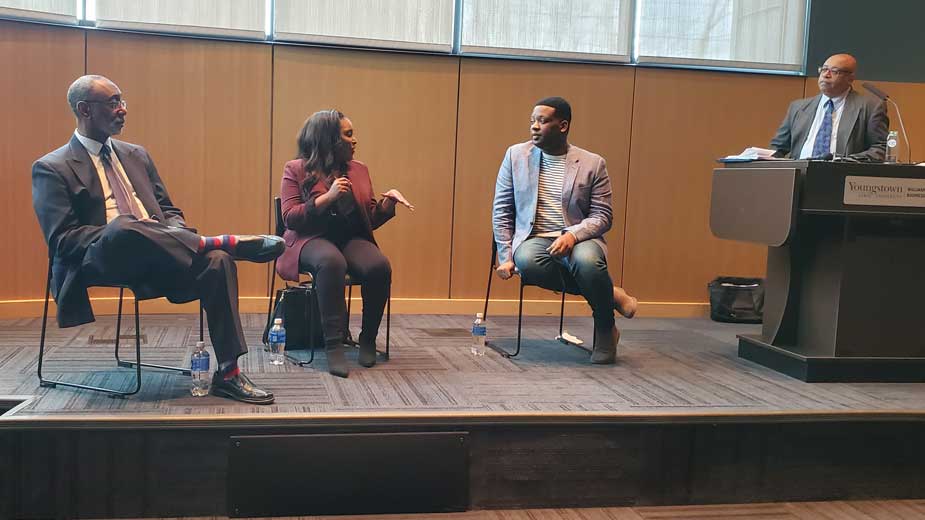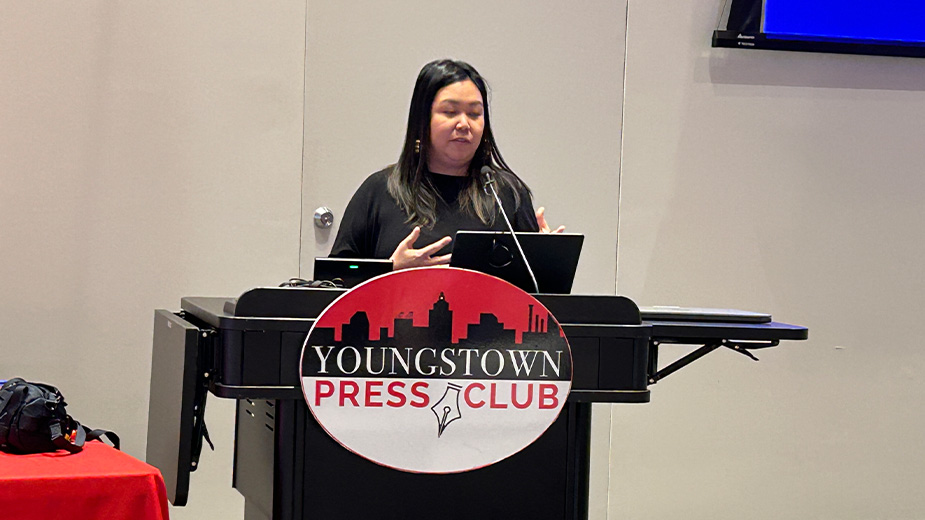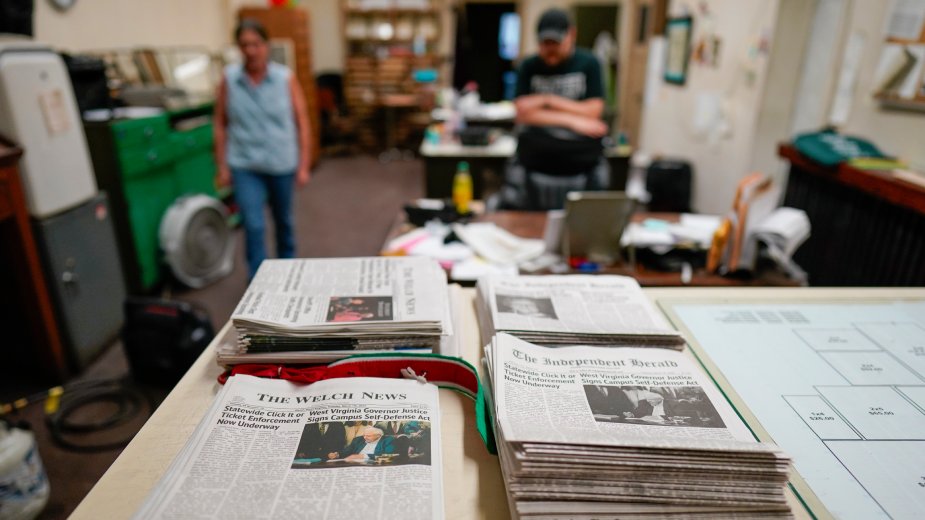Panelists Hope to Inspire Future Black Journalists in Valley
YOUNGSTOWN, Ohio — When people see Malaynia Spiva on the television or in-person, she’s reporting early morning news live. Off-camera, the reporter for 21 WFMJ-TV is poised and collected, smiling and gracious.
For a few moments Thursday, Spiva showed a different side of being a reporter at a panel discussion, Obstacles and Opportunities: The Future of Black Media, about why she works in the Mahoning Valley, rather than be in the nearby Cleveland or Columbus markets.
“I’m from here. I didn’t get to see a lot of Black women on my TV screen. I was watching Cleveland news,” she said. “I think it’s important for young Black girls… when they’re getting ready for school, they see Malaynia Spiva.
“That’s why I’m here. That’s why I plan on staying,” she said, as her voice slightly broke.
Flanked on either side of Spiva were Ernie Brown, former regional editor of The Vindicator, and Aaron Deane, anchor from 33 WYTV-TV.
The presentation, moderated by former WFMJ videographer Art Byrd, was sponsored by the Youngstown Press Club, the Youngstown State University Department of Communication’s Anderson Program in Journalism and Youngstown State University’s Office of Diversity, Equity and Inclusion.
When Brown started with The Vindicator in 1976, there was one other Black person there, he said. For years, he was the only Black reporter and was the first Black person in management at the paper, he said.
Reporters are expected to gather information in a timely manner and provide it to the community, Brown said. “You have to be consistent in that procedure,” he said.
However, that’s not always the case, such as when Black people were arrested on charges and their booking pictures were used, Byrd said. Yet, when white people were arrested, wedding pictures or graduation pictures were used to print with the story.
“These are things that we just have to be more sensitive to, particularly as Black reporters,” Brown said. “We just want to be given the fair opportunity to pursue our craft, just like our white brethren.”
The panelists shared their individual experiences working in journalism, and explained why it’s important for children of color to see people who look like them on the nightly news or working for newspapers.
Deane hopes he inspires other Black children to pursue their dreams of being on TV.
“I’m going to be who I am,” he said, that way, the community watching him deliver the news knows him and that he is representing them. Growing up, he watched two Black people on TV, and he aspired to be like them.
Minorities represent about 5.4% in the newsroom, Byrd said.
During the COVID-19 pandemic, specifically between March 2020 and May 2021, the Center for Community Media at CUNY’s Craig Newmark Graduate School of Journalism analyzed coverage of nearly 100 Black-owned news outlets. The analysis found that Black media provided six times more coverage of issues important to Black communities – including racism, health disparities and voting access – than mainstream outlets.
Otherwise, information won’t be shared with the Black population, Deane remarked.
“We just want our whole story told. Period,” he said.
When asked if the number of minorities in the newsroom could be seen increasing in the near future, Deane responded there are factors that go into play. He noted that he is in his third newsroom now and always has been in the minority. In his newsroom prior to coming to Youngstown, he did work with a Black news director, Black executive producer and Black chief photographer.
“It was good for me as a younger journalist to see someone that looked like me in those kinds of positions because there aren’t that many news directors of color,” Deane said. “It was very impactful for my career and encouraged me to keep going.”
Terminology on-camera and in the newsroom came to mind for Deane when a colleague at a previous newsroom called a Black woman “colored” on air. “It shocked me,” he said.
Deane was told that the reporter grew up in a different environment. “But that doesn’t make it okay,” he said. “There comes a point where you have to try just a little bit harder” because an entire group of people can be offended in an instant.
“We’re trying to educate and inform, and empower,” Deane said.
Echoing Deane’s comments, Spiva said culture has to be taken into consideration.
“Early in my career, it triggered me” when Black people were referred to as “thugs” when peers in the newsroom would talk about someone arrested, she said. Over time, she learned to handle the recurring situation with grace, looking at where each person expressing their opinions off-camera lived and what they have gone through.
“Sometimes when the mic is off, you get to hear some peoples’ opinions,” Spiva said.
Going through police brutality stories over the last couple of years, for example, Spiva said she’s heard people say the suspect “shouldn’t have done this” or that they needed “to hear the whole story first.” Those people don’t realize, she said, how it hurts to hear such comments.
“We all want to hear the whole story, and it doesn’t take away that it’s sad and someone lost a family member,” she said.
Just like handling social media comments, Spiva said if repeated instances happen that hurt a minority colleague, that could be a “teachable moment.” Not everyone has had the same experience, she said.
Pictured: Panelists discussing The Future of Black Media were Ernie Brown, former regional editor of The Vindicator, WFMJ reporter Malaynia Spiva and Aaron Deane, anchor from WYTV. Art Byrd, former photojournalist with WFMJ moderated the discussion.
Copyright 2024 The Business Journal, Youngstown, Ohio.



